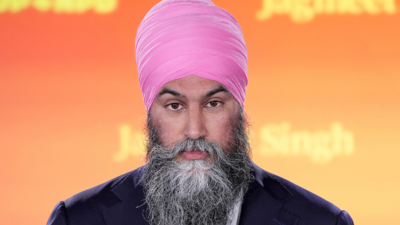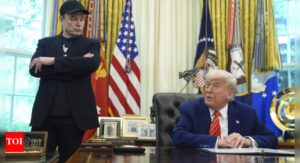Canada election results 2025: Major setback for pro-Khalistan leader Jagmeet Singh as NDP slumps to single digits

The 2025 Canadian federal election has delivered a major blow to the New Democratic Party (NDP) and its leader, Jagmeet Singh. The NDP saw its seat count plummet to single digits out of 343. This dramatic decline from the 25 seats held previously has resulted in the party’s failure to secure the 12 seats needed for official national party status.
Meanwhile, Prime Minister Mark Carney’s Liberal Party won Canada’s federal election and is set to form a minority government. The win was bolstered in part by heightened voter concerns over US President Donald Trump’s annexation threats and escalating trade tensions. The Liberals needed at least 172 seats to achieve a majority in the House of Commons, allowing them to govern without coalition support.
Following the results, Jagmeet Singh announced he would resign as party leader once an interim leader is appointed.
“Choosing to commit your life to politics obviously comes with some sacrifice, but we choose this life because of the chance to change the country you love for the better,” Singh said after conceding defeat.
“We’re only defeated when we believe those that tell us that we can never dream of a better Canada, a fairer Canada, a more compassionate Canada,” he added.
Canada election results 2025
The loss of official party status, which requires a minimum of 12 seats, carries significant implications for the NDP. The party now faces reduced parliamentary funding, limited speaking time in the House of Commons, and diminished committee representation.
The electoral collapse can be attributed to multiple factors, including the Conservative Party’s resurgence under Pierre Poilievre and the Liberal Party’s strong performance under new leader Mark Carney. Both parties effectively captured voters who might have traditionally supported the NDP.
Who is Jagmeet Singh?
Jagmeet Singh assumed leadership of the NDP in 2017, succeeding Tom Mulcair. Before entering federal politics, he served as a Member of Provincial Parliament (MPP) in Ontario from 2011 to 2017. Singh’s rise was historic, as he became the first person from a visible minority group to lead a major Canadian federal political party.
His leadership period was marked by a complex relationship with the Liberal Party, initially serving as a crucial ally to Justin Trudeau‘s government before eventually withdrawing support.
Singh’s pro-Khalistan stance
Adding to the challenges facing Singh is the persistent controversy surrounding his association with the Khalistan movement.
Critics argue that Singh’s engagement with the Khalistan movement has, at times, led to a blurring of the lines between legitimate advocacy and the endorsement of extremist views. His rise to the NDP leadership coincided with a period when the NDP held significant influence over Justin Trudeau’s Liberal Party, leading to accusations that the Liberals were pandering to segments of the Sikh community for electoral gain.
Singh’s attendance at events such as Khalsa Day rallies in Toronto, where pro-Khalistan slogans and imagery have been prominent, has also drawn attention. These events, sometimes attended by other political figures, have been criticized for allegedly providing a platform for extremist sentiments.
Singh’s association with Khalistan politics is not new. Early in his leadership, he faced scrutiny for his responses to questions about Khalistani extremism, particularly regarding the honoring of figures like Talwinder Singh Parmar, convicted of involvement in the Air India bombing. His responses at the time were perceived by some as a reluctance to distance himself decisively from the movement.





